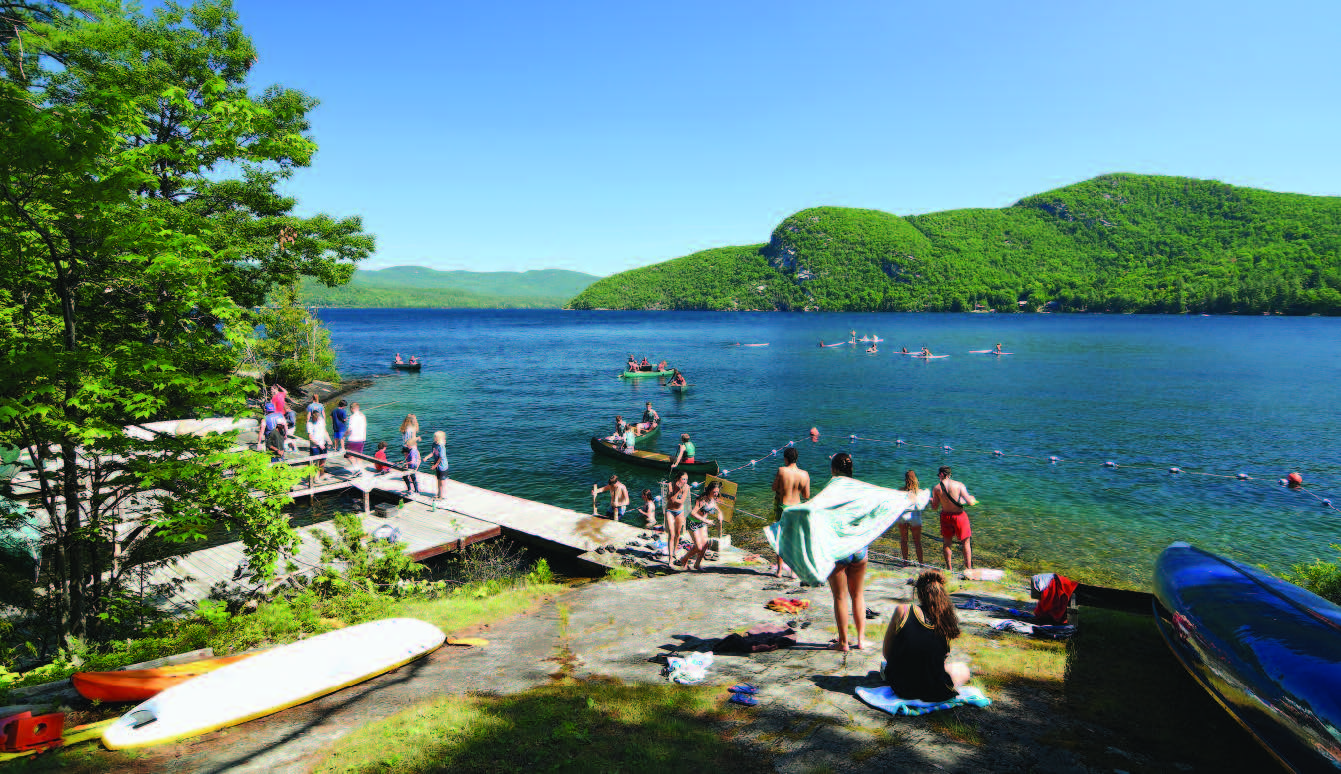Count on summer camps to build aquatic competence in your child.
By Christine Gibbs
New Jersey can proudly boast of more than 200 lakes, about 240 rivers, and countless ponds, streams, and creeks. And that’s before you get to the 100-plus swimmable miles of Jersey Shore between Sandy Hook and Cape May. New Jersey can also lay claim to a good percentage of the 10.4 million residential and 309,000 public swimming pools in the US.
With such a plethora of fresh and saltwater options, the urge to go swimming, sailing, canoeing, kayaking or simply splashing around can be overwhelming.
Unfortunately, it’s not always fun and games. Water safety or, more accurately, water competence is a vital part of a lifelong enjoyment of all things wet and wonderful. Consider the following statistics, which come from Psychology Today:
- Two-thirds of Americans are afraid of deep, natural bodies of water
- 37 percent of Americans are unable to swim
- Almost 4,000 people a year in the United States die from drowning
- 46 percent are afraid of the deep end of a pool
According to CDC statistics, about one in five drowning victims is 13 or younger. Needless to say, water competence is something parents need to instill in their kids at the earliest possible age.
Which is where summer camps come in. A sleep-away or day camp with first-rate aquatic programs and facilities is worth all the extra time and trouble to find, and every extra penny you might have to shell out to build confidence in your kids when it comes to interacting with the water.
Some children seem to emerge from the womb with a love for water. It’s evident from their very first bath. Others not so much. They are burdened with an irrational fear of water, which sometimes originates with their parents’ own fears or insecurities. Wherever it comes from, it can make learning how to swim a seemingly insurmountable challenge. That being said, there are long-established methods for encouraging self-confidence in children who have none, and also to temper any potential overconfidence in more reckless young water enthusiasts. The key is to foster respect for the water at the same time you’re building trust and a sense of security. This is a job best left to the professionals. Parents don’t always make the best swimming teachers. In a summer camp environment, you have trained instructors, lifeguards, other kids to learn with and long-established water culture.
In sorting through summer camp options, make sure you understand what type of water activities each camp offers. In some cases, it’ll be all about the water. In others, a water sport may simply be one of many activities. Whatever you’re drawn to, ask questions about instruction, supervision, and goals. Ideally, you want a camp where the owners/directors and counselors are professionally equipped and personally committed to turning even the most reticent young guppy into a fearless shark. The seven summer camps in these pages are all a little different, but share stellar reputations for their aquatic programs.
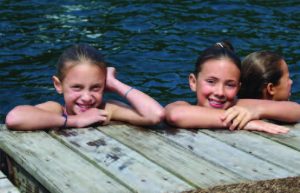
Adirondack Camp
Adirondack Camp
Putnam Station, NY
Co-ed 7 to 17
adirondackcamp.com
Situated on Lake George, “ADK” has roots that run back to 1904. It offers kids two to eight weeks of challenging activities and the opportunity to make new friends from far-off places (20% of the camper population is international).
The camp is surrounded on three sides by the lake. According to Waterfront Director Ryan Harrell, ADK is “the perfect place to go canoeing, wakeboarding, stand-up paddleboarding, windsurfing, sailing, and kayaking. Because we’re on a natural peninsula, activities are not separated one from the other. Although the psychological effect of being in a natural water environment can be intimidating, the various conditions—ranging from deep water to a shallow sandy bottom in our Junior Cove—help to gradually build confidence and fight fear. We work step-by-step and stroke-by-stroke with each child. We strive to keep a safe environment to get our kids to take healthy risks. Our goal is growth through building self-awareness and self-confidence…nothing is more real-world than being on the water.”
As is the case with pretty much all camps located on significant bodies of water, ADK’s kids must take a swimming test when they arrive and participate in appropriate-level swimming lessons (certain activities like canoeing, wind surfing, and kayaking require varying levels of swimming competency). According to Shawn Carraher, a member of the owner’s family, beyond its aquatic program, ADK has a decidedly traditional camp philosophy that “provides an opportunity for campers to develop confidence and leadership skills, and to discover a sense of themselves—all under the guise of having fun.”
From the owners and directors down to the counselors, the focus, adds Carraher, is on understanding the whole child and treating each as an individual. Counselors bunk with the campers and receive pre-camp training in how to get in touch with their charges to help them through any issues or anxieties, such as homesickness or aqua phobia. And although swimming is at the core of the waterfront program, the emphasis is on gradually branching out into the more challenging activities.
Camp Cayuga
Honesdale, PA
Co-ed 5 to 15
Campcayuga.com
Camp Cayuga is located on a secluded 350-acre estate in the Pocono Mountains, which features a junior and senior campus. The camp season is organized into nine different
sessions, ranging from two- to eight-week stays. In all, nearly 400 children from three dozen states and more than a dozen countries attend. The Cayuga staff numbers about 175, so no camper is lacking for supervision or attention.
Much of the activity takes place in or around the property’s 13-acre lake, which features 250 feet of beach, a sand volleyball court, a boathouse, a floating raft with a water slide and a separate fishing dock. According to Director Brian Buynak (a second-generation family owner), Camp Cayuga’s Waterfront Program meets all standards and guidelines of the American Red Cross, as well as the American Camping Association (ACA). The Water Program is under the management of two Waterfront Directors who have a staff of 8-10 fully-certified instructors and lifeguards.
Assistant Director Marcus Whitehurst adds that the water program includes three pools that are used for swimming instruction and recreational activities, including water polo and scuba diving clinics. All campers are required to take a swim test and the younger campers are required to take swimming instruction. Most campers arrive with some level of swimming competence, but all participation in water activities is elective (except for the swimming instruction, if needed).
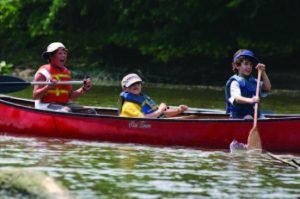
Camp Riverbend
Camp Riverbend
Warren Township, NJ
Co-ed 3 to 14
campriverbend.com
Camp Riverbend, a family-owned and operated day camp, is celebrating its 56th anniversary this year. As its name implies, the property is situated at a bend in the Passaic River in Somerset County. This location is ideal for campers to learn the fundamentals of safe canoeing and kayaking, all under the guidance of certified camp instructors. Swimming is not allowed in the river itself, so campers spend a lot of time around Riverbend’s four swimming pools.
Water Director Robin Breene Hetrick—one of the family owners with 30 years of swim teaching experience—is in charge of managing the swimming program (which includes 18 other instructors) and also seeing that the pools are kept clean, safe, and crystal-clear at all times. The average 750-850 weekly campers are grouped by age and then by swimming ability. The four pools are constructed with 11 inches of water at the low end to accommodate even the youngest campers, who are gradually encouraged to float with face in water, the first step in gaining aquatic confidence.
For the older campers there is an instructional swim every morning and a free swim in the afternoon. Small swim groups are organized by competence (not age), which is assessed on a regular basis by swim evaluations. According to Hetrick, the word “test” is never used. “Instead we just ask the child to show me what you can do,” she says. “Camp Riverbend is all about participation, not competition. We believe there’s too much competition in everyday life, so we want our camp to be a place to escape from pressure. We are hands-on, watchful and supportive. We treat learning to swim just like learning to walk—in gradual stages with an emphasis on improving self-awareness and taking pride in self-improvement.”
Camp Wicosuta
Hebron, NH
Girls 6 to 15
campwicosuta.com
Established in 1920 as one of the region’s first sleep-away camps for girls, Camp Wicosuta boasts a long tradition of morale- and spirit-boosting activities for up to 300 campers in each of its two four-week summer sessions. The web site states that the “goal is for every child to walk away feeling confident,” and it aims to get kids to surpass “their self-set limits.” Wicosuta is a Native American word meaning strength of mind and body.
Camp Director Justin Dockswell says Wicosuta is serious about “our philosophy of the Three C’s—Confidence, Competence and Community. That’s what our staff is dedicated to inspiring in every camper at every age level.” That applies to the aquatic program, which is built around Newfound Lake, which is ranked #7 in a survey of US lakes conducted by USA Today and cited as “one of the cleanest and clearest lakes in America” by National Geographic Magazine.
Camp Wicosuta also has a swimming pool on its campus, which makes the instructional portion of the camp’s water program more inviting, especially since the pool is comfortably heated. Daily swim lessons are required for girls in Grades 1-4, while older girls can work on American Red Cross badges. For more excitement and challenges, girls with the required competency can move onto the lake for training in activities such as canoeing, kayaking, waterskiing, kneeboarding, wakeboarding and sailing. Other lake activities include boat rides, tubing, and a water trampoline. Dockswell estimates that 80 to 85 percent of the camp’s activities involve the lake or pool. Although after Grade 5, campers make elective choices among available activities, water-related options are always the most popular.
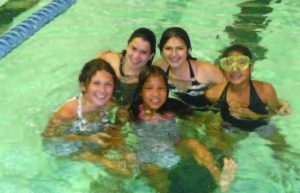
Campus Kids
Campus Kids
Blairstown, NJ
Co-ed • 7 to 15
Campuskids.com
The region’s only weekday sleep-away camp is located on the campus of Blair Academy. Children are picked up in an air-conditioned coach on Monday mornings and returned to their families Friday nights. Each day, campers select their activity for the next day, with programming covering sports, fine arts and performing arts along with other traditional camp activities.
The camp’s pool is indoor and heated, which makes it a popular choice. Every child’s water competence is evaluated the first day, and there are daily swim lessons for every camper under the age of 13, grouped by similar ability. “The pool is also very popular for recreational swimming, as well as evening activities and special events,” says Director Tom Riddleberger, who started Campus Kids in 1991.
The Campus Kids bus fleet does pick-ups from various collection points in Northern and Central New Jersey, and from Manhattan, Rockland and Westchester. Sessions run from two to seven weeks, with about 200 campers in session at a given time.
Valley Forge Military Academy Summer Camp
Wayne, PA
Overnight Boys 9 to 17
Co-ed Day Camp 6- to 17
vfmac.edu/academy/summer-camp
Valley Forge Military Academy, (VFMAC), has a long tradition steeped in instilling values and building self-confidence to prepare tomorrow’s leaders. Not surprisingly, the Academy also offers a rigorous summer camp for both day and overnight campers. The summer camp is run by Elizabeth Wahlberg, Director of Student Activities and Summer Camps, who says the summer sessions reflect the time-honored tradition that has made the Academy itself into such a revered institution. The camp focuses on self-improvement, fitness and leadership, with programs ranging from academic enrichment to physical training. The flavor at sleepover camp is distinctly military (kids sleep in barracks and dine in the mess).
Among VFMAC ’s water-oriented offerings (for both day and sleepover campers) is a specialized scuba diving course. This popular program is conducted by Ultimate Scuba Adventures, a full-service diving center located in Media, PA. The center is certified by the International Professional Association of Diving Instructors (PADI) and the camp program is overseen by Ultimate’s owner, André Horne. Scuba groups at the VMAC camp consist of about a dozen students ranging in age from 10 to 16, all of whom have provided waivers covering medical, liability and parental permission. Each group is supervised by two instructors and a Dive Master, who is responsible for overall pool conditions and safety measures.

www.istockphoto.com
The scuba program is conducted twice each season and is considered to be a Discover Scuba opportunity as opposed to a full-fledged diving course. Each scuba program consists of four 3-hour sessions: 1) orientation, 2) initial diving exercises [e.g., mask clearing, mask recovery], 3) introductory games to develop flexibility and confidence underwater, and 4) a final series of exercises to be conducted for the first time at the deep end of the pool.
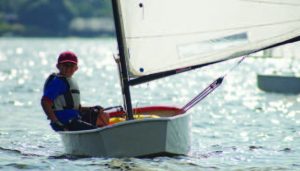
www.istockphoto.com
William Lawrence Camp
Center Tuftonboro, NH
Boys 8 to 15
wlcamp.org
William Lawrence Camp offers an active waterfront program on its half-mile frontage along Lower Beech Pond, which includes swimming and fishing areas. The camp also boasts a small fleet of sailboats, canoes, kayaks and rowboats, as well as a competition water-ski boat. Campers must pass various levels of American Red Cross swimming instruction to progress to the more challenging water activities. Executive Director Nat Crane emphasizes that, despite the popularity of WLC’s water program, it is only a part of the larger camp focus on overall wilderness skills, and keeping boys physically active and personally challenged—including riflery and archery. It’s a perfect blend of exuberance tempered with serious self-improvement, Crane maintains.
“Campers are exposed to an environment that is often the opposite of what they have at home,” he says. “They develop a great sense of community, a tremendous spirit, and a responsibility for themselves and others.”
WLC is more than a century old and differs from the competition in that it’s set up as a not-for-profit, with all funds raised funneled back into the camp. This lowers the cost of the summer program, which runs seven weeks (divided into three- and four-week sessions). The staff to camper ratio is 2:1, and more than three-quarters of campers typically return the following summer.
When choosing a camp—whether water competence is your highest priority or not—your number-one job as a parent is to know your child. This means accepting your child’s level of physical development and emotional maturity, along with an awareness of his or her personal preferences. There are the basic questions: Is your child ready for a sleepover camp or would a day camp be preferable? Would your child like to be near to home or prefer an adventure farther afield? Is your child a natural water rat or a no way/not me water baby? In terms of a camp’s water program, don’t just go by the pictures on the web site or brochure. Look at reviews and comments from other parents. Call and ask questions, too. Find out what water safety regulations are in place, and what kind of swimmers attend the camp. And obviously, look at a camp’s other programmed activities and make sure they relate to your child’s interests.
Once all these questions have been answered, the final and best choice should become much clearer. That leaves only two catches—does it fit in your budget and is space still available? Generally speaking, there are camps to fit every pocketbook. But the best ones tend to book up quickly, so if you haven’t begun your search at this point you may have to hustle.
As a final footnote, be ready to be proud. If you’ve done your homework and made the right choice, you might not recognize the child you pick up from camp as the same one you dropped off.
START ’EM YOUNG
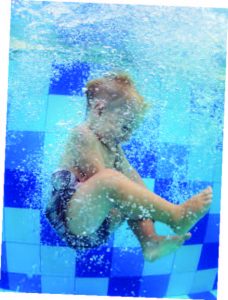
www.istockphoto.com
There are solid numbers to back this up. USA Swimming, the national governing body for the sport, has indicated that participation in formal swimming lessons can reduce the risk of drowning by as much as 88 percent among children aged one to four years. Psychology Today points out that “even more than learning strokes, learning to cope with fear and maintaining ease in the water is what prevents drowning.” For most of us, that begins with childhood swimming instruction. In cases of extreme fear, there are experts ready to step in—Jeff Krieger’s Strategies for Overcoming Aquatic Phobias (S.O.A.P.) and Kimberlee Shults’ program, called Face in Water, to name a couple.
MARCO POLO TO WATER POLO
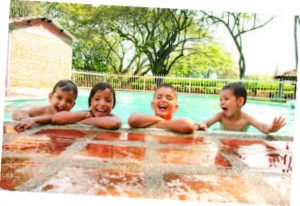
www.istockphoto.com
Many child psychologists and swimming coaches emphasize that swimming for fun—ranging from playing Marco Polo to competing in serious water polo—is one of the best ways to instill not just a love of water, but also a painless appreciation of cardio activities. Children don’t even realize they are exercising when they’re in the water; they are just enjoying themselves. Swimming is the fourth-most popular cardio activity among Americans (walking and gym-type activities hold the top spots) according to the US Census Bureau. Among youngsters aged 7 to 17, swimming easily moves into the #1 position according to Safe Kids Worldwide.
Editor’s Note: There are any number of ways to begin a summer camp search. The American Camp Association web site (acacamps.org) is a good place to start. If water

